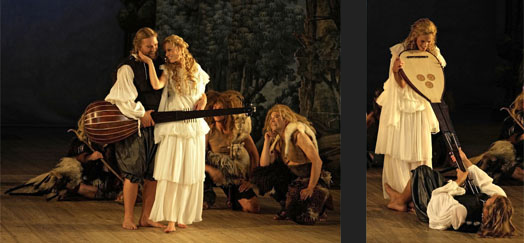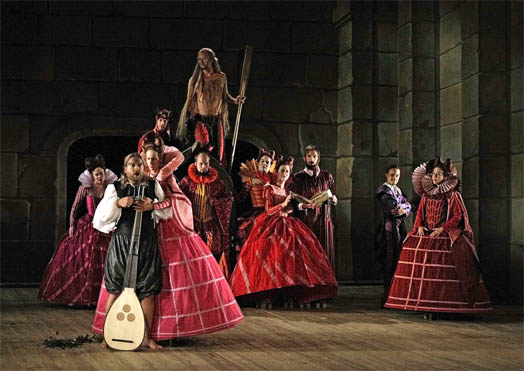L’ORFEO
FAVOLA IN MUSICA VAN CLAUDIO MONTEVERDI
FOTO'S © Bo Ljungblom / Drottningholms Slottsteater 2007
PRODUCTIE
Drottningholms Slottsteater Stockholm
artistiek directeur: Mark Tatlow
première: 28 juli 2007
muzikale leiding: Mark Tatlow
regie / vormgeving: Michiel Dijkema
kostuums: Claudia Damm
orkest: Drottningholmsteaterns Orkester
La Musica: Susanne Rydén
Orfeo: Rickard Söderberg
Euridice: Ida Falk Winland
Messaggiera: Lina Markeby
Speranza: Mikael Bellini
Caronte: Lars Arvidson
Proserpina: Anna Grevelius
Plutone: Lars Johansson Brissman
Apollo: Ulf Lundmark
Eco: Conny Thimander
Pastori, ninfe e spiriti: Joel Annmo, Anna Grevelius, Lina Markeby, Mikael Bellini, Ulf Lundmark, Conny Thimander, Johan Christensson, Susanne Rydén, Lars Arvidson, Lars Johansson Brissman, Emelie Roos (blokfluit) en Kate Hearne (blokfluit)
IN DE PERS
“hoogwaardige, sluitende totaalindruk”
Als de mens in staat zou zijn door de tijd te reizen, dan zou het hem nauwelijks zijn opgevallen, dat deze enscenering van dit 400 jaar oude meesterwerk in 2007 plaatsvond. De kostuums ademen de sfeer van de renaissance; Claudia Damm heeft de kleding met grote zorgvuldigheid vormgegeven – gebaseerd op historische inspiratiebronnen met uiterst respect voor traditie en realiteit. Een tot in de kleinste details stemmig samengesteld ensemble van zangeracteurs leverde een uitmuntende prestatie, bracht Monteverdi’s eerste opera met ongelooflijke authenticiteit tot leven. […] Mark Tatlow leidde het theaterorkest met elan en inlevingsvermogen, talrijke historische instrumenten leverden betoverende klankeffecten op. De dirigent verloor de zangers nooit uit het oog en leidde ze soeverein door de ritmisch vaak lastige partituur. De samenwerking met regisseur Michiel Dijkema was congeniaal en had een hoogwaardige, sluitende totaalindruk tot resultaat.
G. Helbig
Das Opernglas
september 2007
“als een echo van de antieken”
Director Michiel Dijkema kept the action anchored in a setting echoing antiquity with a hint of the early seventeenth century. The action started out in a pastoral forest. The death of Euridice saw Orpheus enter a stone-clad hall and descend to a seventeenth-century version of Hades, where Persephone, seemingly smitten with the semi-god, stepped in to put Caronte to sleep, thus negating the original power of Orpheus´s music. The underworld found the chorus transformed into seventeenth-century courtiers, with a guest appearance by Dante to mark a literary link between antiquity and the Renaissance. Costume designer Claudia Damm´s flowing antique garments for the nymphs and the shepherds were transformed into lusty, dreadlock-haired and hide-clad satyrs, while Orpheus appeared in shirt and trousers.
Framing the action was the playful, rather mischievous Musica of Susanne Rydén, who engaged in interplay with the orchestra, stealing a lute from one of the players to bestow it on Orpheus (instead of the usual lyre) and returning it, used and broken, with a wink at the end of the performance. […] Apollo first appeared Bacchus-like, as the leader of the satyrs, clad in hides and carrying a stag across his shoulders. His sudden transformation at the end, revealing golden garments underneath his rough attire, was a well-placed comment on the coexistence of Bacchus and Apollo. Orpheus was borne away into a night sky, not into the sunrise.
Ingrid Gäfvert
Opera News
oktober 2007, vol. 72, nr. 4
“fris en vol charme”
Sweden’s most famous historic theatre dates from more than 150 years after the first opera to survive in the modern repertoire, but provided entirely apt for Monteverdi’s Orfeo, with its Arcadia-meets-court-opera location. In any case, Orfeo’s original production, at the court of Mantua in 1607, must have been somewhat makeshift, as the ducal hall could have had little in the way of the kind of quick-change set machinery that Drottningholm boasts.
Accordingly Michiel Dijkema kept things simple with a few scene changes as the drama allows, using Drottningholm’s stock of perspective wings and backdrops only slightly less sparingly than Pierre Audi did for his remarkable Tamerlano here a few years back.
With a young and entirely Swedish cast, singing in the original Italian and wearing stylish period costumes by Claudia Damm, this Orfeo had a freshness and charm in the pastoral scenes which few more sophisticated ‘modern’ stagings of recent years have matched. […] The singers, all good actors, also proved animated and accomplished dancers in a staging that showed again how Orfeo is the first inspired masterpiece of the art form, as exhilarating and moving as anything written later.
Hugh Canning
Opera
november 2007
“visueel hoogst poetisch”
Partant de ce postulat clair et direct, la réalisation de Michiel Dijkema trouve sans encombre le bon chemin. Son travail paraît d’autant plus efficace, subtil et sensible que la machinerie si spécifique de Drottningholm n’autorise pas toujours une telle souplesse de propos. Epaulé par la créativité ébouriffante de Claudia Damm, dont les costumes sont une pure folie, le metteur en scène règle un spectacle d’un impact visuel hautement poétique, les chanteurs, intelligemment dirigés, offrant le meilleur d’eux-mêmes ou presque.
Opéra Magazin
november 2007





















